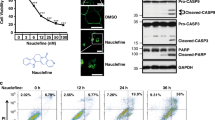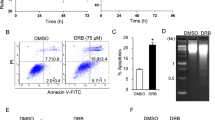Abstract
Indirubin, an isomer of indigo, is a reported inhibitor of cyclin-dependent kinases (CDKs) and glycogen synthase kinase-3 (GSK-3) as well as an agonist of the aryl hydrocarbon receptor (AhR). Indirubin is the active ingredient of a traditional Chinese medicinal recipe used against chronic myelocytic leukemia. Numerous indirubin analogs have been synthesized to optimize this promising kinase inhibitor scaffold. We report here on the cellular effects of 7-bromoindirubin-3′-oxime (7BIO). In contrast to its 5-bromo- and 6-bromo- isomers, and to indirubin-3′-oxime, 7BIO has only a marginal inhibitory activity towards CDKs and GSK-3. Unexpectedly, 7BIO triggers a rapid cell death process distinct from apoptosis. 7-Bromoindirubin-3′-oxime induces the appearance of large pycnotic nuclei, without classical features of apoptosis such as chromatin condensation and nuclear fragmentation. 7-Bromoindirubin-3′-oxime-induced cell death is not accompanied by cytochrome c release neither by any measurable effector caspase activation. Furthermore, the death process is not altered either by the presence of Q-VD-OPh, a broad-spectrum caspase inhibitor, or the overexpression of Bcl-2 and Bcl-XL proteins. Neither AhR nor p53 is required during 7BIO-induced cell death. Thus, in contrast to previously described indirubins, 7BIO triggers the activation of non-apoptotic cell death, possibly through necroptosis or autophagy. Although their molecular targets remain to be identified, 7-substituted indirubins may constitute a new class of potential antitumor compounds that would retain their activity in cells refractory to apoptosis.
This is a preview of subscription content, access via your institution
Access options
Subscribe to this journal
Receive 50 print issues and online access
$259.00 per year
only $5.18 per issue
Buy this article
- Purchase on Springer Link
- Instant access to full article PDF
Prices may be subject to local taxes which are calculated during checkout













Similar content being viewed by others
Abbreviations
- AhR:
-
aryl hydrocarbon receptor
- ARNT:
-
aryl hydrocarbon receptor nuclear translocator
- BIO:
-
bromoindirubin-3′-oxime
- CDK:
-
cyclin-dependent kinase
- FCS:
-
fetal calf serum
- FLT-3:
-
FMS-like tyrosine kinase 3
- GSK-3:
-
glycogen synthase kinase-3
- IFNα:
-
interferon α
- IO:
-
indirubin-3′-oxime
- LDH:
-
lactate dehydrogenase
- MeBIO:
-
1-methyl-bromoindirubin-3′-oxime
- MeIO:
-
1-methyl-indirubin-3′-oxime
- MTS:
-
3-(4,5-dimethylthiazol-2-yl)-5-(3-carboxymethoxyphenyl)-2-(4-sulfophenyl)-2H-tetrazolium
- RA:
-
retinoic acid
- ROS:
-
reactive oxygen species
- STS:
-
staurosporine
- TCDD:
-
2,3,7,8-tetrachlorodibenzo-p-dioxin
References
Adachi J, Mori Y, Matsui S, Takigami H, Fujino J, Kitagawa H et al. (2001). J Biol Chem 276: 31475–31478.
Bach S, Blondel M, Meijer L . (2006). In: Yue E and Smith PJ (eds). Monographs on Enzyme Inhibitors. Vol. 2. CDK Inhibitors and their Potential as Anti-Tumor Agents. CRC Press: Boca Raton, in press.
Baehecke EH . (2005). Nat Rev Mol Cell Biol 6: 505–510.
Balfour-Paul J . (1998). Indigo. British Museum Press: London.
Benson C, Kaye S, Workman P, Garrett M, Walton M, de Bono J . (2005). Br J Cancer 92: 7–12.
Bertrand JA, Thieffine S, Vulpetti A, Cristiani C, Valsasina B, Knapp S et al. (2003). J Mol Biol 33: 393–407.
Broker LE, Kruyt FA, Giaccone G . (2005). Clin Cancer Res 11: 3155–3162.
Caserta TM, Smith AN, Gultice AD, Reedy MA, Brown TL . (2003). Apoptosis 8: 345–352.
Chipuk JE, Green DR . (2005). Nat Rev Mol Cell Biol 6: 268–275.
Cohen P . (2002). Nat Rev Drug Discov 1: 309–315.
Cooksey CJ . (2001). Molecules 6: 736–769.
Damiens E, Baratte B, Marie D, Eisenbrand G, Meijer L . (2001). Oncogene 20: 3786–3797.
Davies TG, Tunnah P, Meijer L, Marko D, Eisenbrand G, Endicott JA et al. (2001). Structure 9: 389–397.
Degterev A, Huang Z, Boyce M, Li Y, Jagtap P, Mizushima N et al. (2005). Nat Chem Biol 1: 112–119.
Denison MS, Nagy SR . (2003). Annu Rev Pharmacol Toxicol 43: 309–334.
Elferink CJ . (2003) In: Meijer L, Jezequel A and Roberge M (eds). Progression Cell Cycle Research. Station Biologique de Roscoff: France, pp 261–267; Progr Cell Cycle Res, vol. 5, Life in Progress.
Fischer PM . (2004). Curr Med Chem 11: 1563–1583.
Fischer PM, Endicott J, Meijer L . (2003) In: Meijer L, Jézéquel A, RobergeM (eds). Progression Cell Cycle Research. Station Biologique de Roscoff: France, pp 235–248; Progr Cell Cycle Res, vol. 5, edns, Life in Progress.
Fischer PM, Gianella-Borradori A . (2005). Exp Opin Investig Drugs 14: 457–477.
Guengerich FP, Sorrells JL, Schmitt S, Krauser JA, Aryal P, Meijer L . (2004). J Med Chem 47: 3236–3241.
Hoessel R, Leclerc S, Endicott J, Noble M, Lawrie A, Tunnah P et al. (1999). Nat Cell Biol 1: 60–67.
Holton S, Merckx A, Burgess D, Doerig C, Noble M, Endicott J . (2003). Structure 11: 1329–1337.
Jaattela M . (2004). Oncogene 23: 2746–2756.
Jautelat R, Brumby T, Schafer M, Briem H, Eisenbrand G, Schwahn S et al. (2005). Chembiochem 6: 531–540.
Kane DJ, Ord T, Anton R, Bredesen DE . (1995). J Neurosci Res 40: 269–275.
Kawanishi M, Sakamoto M, Ito A, Kishi K, Yagi T . (2003). Mutat Res 540: 99–105.
Knockaert M, Blondel M, Bach S, Leost M, Elbi C, Hager G et al. (2004). Oncogene 23: 4400–4412.
Knockaert M, Greengard P, Meijer L . (2002). Trends Pharmacol Sci 23: 417–425.
Kolluri SK, Weiss C, Koff A, Göttlicher M . (1999). Genes Dev 13: 1742–1753.
Kosmopoulou MN, Leonidas DD, Chysina ED, Bischler N, Eisenbrand G, Sakarellos CE et al. (2004). Eur J Biochem 271: 2280–2290.
Leclerc S, Garnier M, Hoessel R, Marko D, Bibb JA, Snyder GL et al. (2001). J Biol Chem 276: 251–260.
Lee JW, Moon MJ, Min HY, Chung HJ, Park EJ, Park HJ et al. (2005). Bioorg Med Chem Lett 15: 3948–3952.
Lu H, Chang DJ, Baratte B, Meijer L, Schulze-Gahmen U . (2005). J Med Chem 48: 737–743.
Mapelli M, Massimiliano L, Crovace C, Seeliger M, Tsai LH, Meijer L et al. (2005). J Med Chem 48: 671–679.
Marko D, Schätzle S, Friedel A, Genzlinger A, Zankl H, Meijer L et al. (2001). Br J Cancer 84: 283–289.
Meijer L, Borgne A, Mulner O, Chong JPJ, Blow JJ, Inagaki N et al. (1997). Eur J Biochem 243: 527–536.
Meijer L, Skaltsounis AL, Magiatis P, Polychronopoulos P, Knockaert M, Leost M et al. (2003). Chem Biol 10: 1255–1266.
Merz KH, Schwahn S, Hippe F, Muhlbeyer S, Jakobs S, Eisenbrand G . (2004). Int J Clin Pharmacol Ther 42: 656–658.
Nam S, Buettner R, Turkson J, Kim D, Cheng JQ, Muehlbeyer S et al. (2005). Proc Natl Acad Sci USA 102: 5998–6003.
Noble ME, Endicott JA, Johnson LN . (2004). Science 303: 1800–1805.
Polychronopoulos P, Magiatis P, Skaltsounis L, Myrianthopoulos V, Mikros E, Tarricone A et al. (2004). J Med Chem 47: 935–994.
Ribas J, Gomez-Arbones X, Boix J . (2005). Eur J Pharmacol 524: 49–52.
Ribas J, Boix J . (2004). Exp Cell Res 295: 9–24.
Spink BC, Hussain MM, Katz BH, Eisele L, Spink DC . (2003). Biochem Pharmacol 66: 2313–2321.
Sugihara K, Kitamura S, Yamada T, Okayama T, Ohta S, Yamashita K et al. (2004). Biochem Biophys Res Commun 318: 571–578.
Teng X, Degterev A, Jagtap P, Xing X, Choi S, Denu R et al. (2005). Bioorg Med Chem Lett 15: 5039–5044.
Vermeulen K, Van Bockstaele DR, Berneman ZN . (2003). Cell Prolif 36: 131–149.
Weinmann H, Metternich R . (2005). Chem Biol Chem 6: 455–459.
Weiss C, Kolluri SK, Kiefer F, Göttlicher M . (1996). Exp Cell Res 226: 154–163.
Wu ZL, Aryal P, Lozach O, Meijer L, Guengerich FP . (2005). Chem Biodiv 2: 51–65.
Xiao Z, Hao Y, Liu B, Qian L . (2002). Leukemia Lymphoma 43: 1763–1768.
Yuste VJ, Sanchez-Lopez I, Sole C, Encinas M, Bayascas JR, Boix J et al. (2002). J Neurochem 80: 126–139.
Acknowledgements
We thank our colleagues for providing reagents: Dr Martin Goëttlicher, Dr Steve Safe, Dr Bert Vogelstein. This research was supported a grant from the EEC (FP6-2002-Life Sciences & Health, PRO-KINASE Research Project) (LM), and a ‘Cancéropole Grand-Ouest’ grant (LM). KB was supported by a fellowship from the ‘Ministère de la Recherche’. The Molecular Pharmacology Group thank the ‘Instituto de Salud Carlos III’ (PI041488, 2005-2007) for financial support.
Author information
Authors and Affiliations
Corresponding author
Rights and permissions
About this article
Cite this article
Ribas, J., Bettayeb, K., Ferandin, Y. et al. 7-Bromoindirubin-3′-oxime induces caspase-independent cell death. Oncogene 25, 6304–6318 (2006). https://doi.org/10.1038/sj.onc.1209648
Received:
Revised:
Accepted:
Published:
Issue Date:
DOI: https://doi.org/10.1038/sj.onc.1209648
Keywords
This article is cited by
-
Cellular, Biophysical and in Silico Binding Study of β-Estradiol-6-one 6- (O-carboxy methyl Oxime) with Tubulin in Search of Antimitotic Derivative of 2-Methoxy Estradiol
Cell Biochemistry and Biophysics (2023)
-
Updating dual-specificity tyrosine-phosphorylation-regulated kinase 2 (DYRK2): molecular basis, functions and role in diseases
Cellular and Molecular Life Sciences (2020)
-
Portraying the selectivity of GSK-3 inhibitors towards CDK-2 by 3D similarity and molecular docking
Structural Chemistry (2019)
-
Indirubin inhibits the migration, invasion, and activation of fibroblast-like synoviocytes from rheumatoid arthritis patients
Inflammation Research (2017)
-
5-Aminolevulinic Acid-Mediated Sonodynamic Therapy Inhibits RIPK1/RIPK3-Dependent Necroptosis in THP-1-Derived Foam Cells
Scientific Reports (2016)



